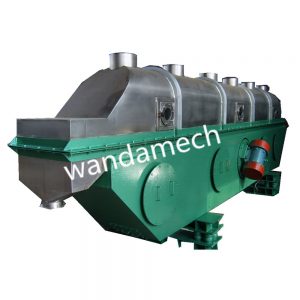
Vibrating fluidized bed is suitable for particles larger than 50 μ M is a special equipment for drying powder, crystal and granular materials. It is a fluidized bed drying device with additional vibration to enhance heat and mass transfer. As mechanical vibration helps fluidize materials during drying, it is not only conducive to boundary layer turbulence, enhancing heat and mass transfer, but also ensures that it works under relatively stable hydrodynamic conditions. In addition to having good drying function, the equipment can also add materials granulation, cooling, screening and transportation processes to the vibrating fluidized bed dryer according to process needs.
The small fluidized bed host is generally integrated, and the large equipment is generally split (the settling chamber does not vibrate) to reduce the vibration mass. According to the material characteristics and process requirements, the vibrating fluidized bed can be redesigned to avoid multi-point discharge and simplify the product mixing process through the built-in bag filter in the settling chamber. Please put forward the equipment or process requirements to Changzhou Kemao before ordering.
In the fluidized bed, after the gas is evenly distributed through the pressure equalizing distribution plate, it passes through the bed material, so that the material is suspended in the air stream, forming fluidization. The specific surface area between the material and the hot medium is increased, so that the material is evenly mixed, and sufficient heat and mass transfer is carried out, providing ideal process conditions for the drying and cooling process of the material. The fluidization of materials reduces the heat and mass transfer resistance of the gas film, and the thermal efficiency is high, up to 60% – 80%. It is widely used for drying, cooling and humidifying powder, crystal and granular materials in chemical industry, light industry, medicine, food, plastics, grain and oil, slag, salt making, sugar and other industries. When used as a drying device, the device can have both drying and cooling functions, and the product can be directly packaged. Large equipment generally adopts split type, so as to reduce the vibration quality and energy consumption as much as possible.
Vibrating fluidized bed is a very successful modified fluidized bed. Adding mechanical vibration to the fluidized bed is called vibrating fluidized bed. The additional vibration of the bed reduces the heat and mass transfer resistance. The drying rate in the vibrated fluidized bed is 1.5~2.5 times higher than that in the convective fluidized bed. The drying speed of constant speed drying stage is several times higher than that of fixed bed. It is worth mentioning that the critical water content is also reduced due to vibration during the speed reduction drying stage. Vibration can adjust the resonance frequency of the water contained in the solid capillary, so that the water combined in molecular form is partially eliminated due to vibration.
The standard vibrating fluidized bed pressure equalizing bellows, fluidization section and sedimentation section are composed of three parts. Heat energy is transferred from hot air to the surface of wet materials in a cross flow manner, and is heated and dried in the fluidizing section. The wet materials are mixed and collided with each other under the action of hot air flow and vibration force, so as to ensure full mass and heat transfer between the wet materials and the hot air flow, so that the material layer on the bed surface maintains a uniform and directional fluidized state. The entrained particles are separated from the air flow in the expansion section and settled in the fluidizing section, and the dried products are discharged from the outlet. Waste gas is discharged after purification by cyclone separator.
Scope of application:
It is suitable for drying, cooling and humidification of powder, crystal, granular materials and granular materials made of powder in chemical, pharmaceutical, food, dehydrated vegetables, grain, mineral and other industries. Such as citric acid, monosodium glutamate, chicken essence, boric acid, borax, ammonium sulfate, compound fertilizer, soybean meal, distiller’s grains, seeds, slag, granulated sugar, sodium gluconate, sodium fluosilicate, etc.
Performance characteristics:
Compared with other particle drying processes, fluidized bed drying process has many advantages:
1. Granular raw materials can be easily fluidized and transported for processing.
2. For drying heat sensitive products, it can avoid local material overheating and has strong adaptability. It does not degrade the molecular weight of the product and does not damage the physical and chemical properties of the product.
3. Because the fluidized bed can provide a large contact area for materials and fluid medium, so that materials can be uniformly mixed and full heat and mass transfer can be carried out, it has a very high thermal efficiency.
4. Tube bundle type or flat plate type heat exchanger can be set in the fluidized bed for indirect heating or cooling, which can enable materials to achieve a higher evaporation rate at a lower temperature, significantly saving energy consumption and reducing waste gas purification facilities. 5. Drying and cooling can be effectively carried out in a combined fluidized bed, thus saving investment and reducing production costs.
6. Automatically collect important data such as drying medium temperature and bed surface negative pressure in each section to realize computer control and meet the requirements of drying process.
7. Fluidized bed is suitable for average particle size of 50 μ Granular, powdery and blocky products of m-5mm.
8. It has little damage to the material surface and can be used for drying fragile materials; Irregular material particles will not affect the working effect.
9. Good adjustability and wide adaptability. The thickness of the material layer, the moving speed in the machine and the uniform change of the full amplitude can realize stepless adjustment.
10. The fully enclosed structure is adopted to effectively prevent the infection of empty forks between materials and air. The working environment is clean.

 中文
中文 Русский
Русский

